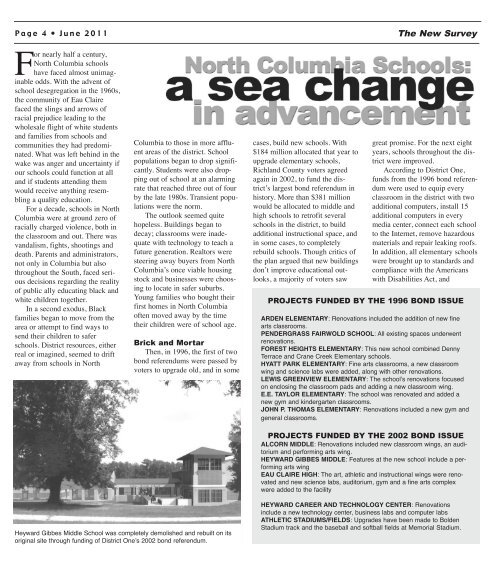The New Survey - Eau Claire Community Council
The New Survey - Eau Claire Community Council
The New Survey - Eau Claire Community Council
Create successful ePaper yourself
Turn your PDF publications into a flip-book with our unique Google optimized e-Paper software.
Page 4 • June 2011<br />
For nearly half a century,<br />
North Columbia schools<br />
have faced almost unimaginable<br />
odds. With the advent of<br />
school desegregation in the 1960s,<br />
the community of <strong>Eau</strong> <strong>Claire</strong><br />
faced the slings and arrows of<br />
racial prejudice leading to the<br />
wholesale flight of white students<br />
and families from schools and<br />
communities they had predominated.<br />
What was left behind in the<br />
wake was anger and uncertainty if<br />
our schools could function at all<br />
and if students attending them<br />
would receive anything resembling<br />
a quality education.<br />
For a decade, schools in North<br />
Columbia were at ground zero of<br />
racially charged violence, both in<br />
the classroom and out. <strong>The</strong>re was<br />
vandalism, fights, shootings and<br />
death. Parents and administrators,<br />
not only in Columbia but also<br />
throughout the South, faced serious<br />
decisions regarding the reality<br />
of public ally educating black and<br />
white children together.<br />
In a second exodus, Black<br />
families began to move from the<br />
area or attempt to find ways to<br />
send their children to safer<br />
schools. District resources, either<br />
real or imagined, seemed to drift<br />
away from schools in North<br />
Columbia to those in more affluent<br />
areas of the district. School<br />
populations began to drop significantly.<br />
Students were also dropping<br />
out of school at an alarming<br />
rate that reached three out of four<br />
by the late 1980s. Transient populations<br />
were the norm.<br />
<strong>The</strong> outlook seemed quite<br />
hopeless. Buildings began to<br />
decay; classrooms were inadequate<br />
with technology to teach a<br />
future generation. Realtors were<br />
steering away buyers from North<br />
Columbia’s once viable housing<br />
stock and businesses were choosing<br />
to locate in safer suburbs.<br />
Young families who bought their<br />
first homes in North Columbia<br />
often moved away by the time<br />
their children were of school age.<br />
Brick and Mortar<br />
<strong>The</strong>n, in 1996, the first of two<br />
bond referendums were passed by<br />
voters to upgrade old, and in some<br />
cases, build new schools. With<br />
$184 million allocated that year to<br />
upgrade elementary schools,<br />
Richland County voters agreed<br />
again in 2002, to fund the district’s<br />
largest bond referendum in<br />
history. More than $381 million<br />
would be allocated to middle and<br />
high schools to retrofit several<br />
schools in the district, to build<br />
additional instructional space, and<br />
in some cases, to completely<br />
rebuild schools. Though critics of<br />
the plan argued that new buildings<br />
don’t improve educational outlooks,<br />
a majority of voters saw<br />
<strong>The</strong> <strong>New</strong> <strong>Survey</strong><br />
great promise. For the next eight<br />
years, schools throughout the district<br />
were improved.<br />
According to District One,<br />
funds from the 1996 bond referendum<br />
were used to equip every<br />
classroom in the district with two<br />
additional computers, install 15<br />
additional computers in every<br />
media center, connect each school<br />
to the Internet, remove hazardous<br />
materials and repair leaking roofs.<br />
In addition, all elementary schools<br />
were brought up to standards and<br />
compliance with the Americans<br />
with Disabilities Act, and<br />
PROJECTS FUNDED BY THE 1996 BOND ISSUE<br />
ARDEN ELEMENTARY: Renovations included the addition of new fine<br />
arts classrooms.<br />
PENDERGRASS FAIRWOLD SCHOOL: All existing spaces underwent<br />
renovations.<br />
FOREST HEIGHTS ELEMENTARY: This new school combined Denny<br />
Terrace and Crane Creek Elementary schools.<br />
HYATT PARK ELEMENTARY: Fine arts classrooms, a new classroom<br />
wing and science labs were added, along with other renovations.<br />
LEWIS GREENVIEW ELEMENTARY: <strong>The</strong> school’s renovations focused<br />
on enclosing the classroom pads and adding a new classroom wing.<br />
E.E. TAYLOR ELEMENTARY: <strong>The</strong> school was renovated and added a<br />
new gym and kindergarten classrooms.<br />
JOHN P. THOMAS ELEMENTARY: Renovations included a new gym and<br />
general classrooms.<br />
PROJECTS FUNDED BY THE 2002 BOND ISSUE<br />
ALCORN MIDDLE: Renovations included new classroom wings, an auditorium<br />
and performing arts wing.<br />
HEYWARD GIBBES MIDDLE: Features at the new school include a performing<br />
arts wing<br />
EAU CLAIRE HIGH: <strong>The</strong> art, athletic and instructional wings were renovated<br />
and new science labs, auditorium, gym and a fine arts complex<br />
were added to the facility<br />
Heyward Gibbes Middle School was completely demolished and rebuilt on its<br />
original site through funding of District One’s 2002 bond referendum.<br />
HEYWARD CAREER AND TECHNOLOGY CENTER: Renovations<br />
include a new technology center, business labs and computer labs<br />
ATHLETIC STADIUMS/FIELDS: Upgrades have been made to Bolden<br />
Stadium track and the baseball and softball fields at Memorial Stadium.




